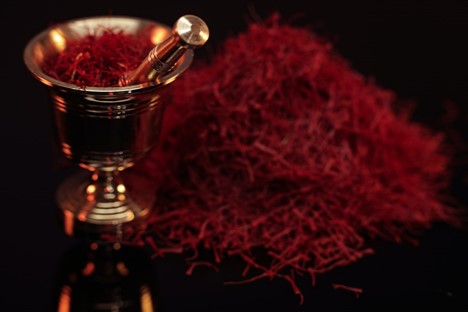An experience of flawless skin is primarily the result of consistent and rigorous beauty practices. It becomes difficult to deal with skin issues such as pigmentation, dullness, and acne.
These skin problems arise when you do not follow effective skincare practices every day. Many expensive skincare products have claimed to give you a spotless and fair skin complexion to provide a solution to different skin-related problems. But, the presence of chemical gives short-term effect and tend to influence skin health negatively.
Therefore, one of the best natural alternate products for such issues is saffron which is being used in synthetic cosmetic products. However, this nutty-tasting and sweet spice are one of the most expensive spices around the world.
Despite the high cost, it is highly preferred for its medicinal benefits for thousands of years. It significantly provides total-body benefits such as protection, calming, and brightening the skin.
What is saffron?

One of the traditionally used ayurvedic medicine – Saffron, is quite rare, which makes it costly. The appearance of saffron is like little stems or stigmas from the crocus sativus, an Iris family flower. Around one pound of saffron, the yield comes from approximately 170,000 flowers.
The other reason for its high cost lies in its harvesting period, i.e., around two weeks in a year, and each flower needs to be picked by hand, not any machine.
Typically, the common use of saffron is in cooking because it gives a bright yellow-orange tint to food. Other uses include the production of perfumes and fabric dyes throughout the world.
The origin and first cultivated area of saffron are Greece. Today, it is grown in India, Morocco, Greece, Iran, and a small amount of saffron flower is also grown in the United States. Other countries in the world import saffron.
Why is saffron beneficial for the skin?
The consumption of saffron provides wide-ranging and impressive health benefits – this can be considered for the skin.
The stigmas of a red flower represent a wide range of medicinal and health benefits, which are difficult to be listed. They contain a high amount of antioxidants which mainly include Vitamin C, and also have antibacterial and anti-inflammatory properties. It also contains a high amount of minerals, but the skin healing properties are due to be the presence of carotenoids, i.e., crocin and crocetin.
The natural occurrence of carotenoids in plants helps in photosynthesis, which serves as the great carotenoids source. Cartenoids are also effective in repairing the damage and ensures the good health of the cells. Therefore, they help recover skin from sun damage, oxidative and environmental stress and heal skin from photodamage to restrict the suppleness loss.
Similarly, the topical application of saffron helps promote blood circulation, brings significant improvement in the appearance of scars, reduces the fatigue lines and appearance of dark circles, and lightens the hyperpigmentation.
In addition to this, the anti-inflammatory properties of saffron tend to be ideal for people who have sensitive skin. Because saffron acts as a calming agent and provides skin brightening results. Being an antioxidant, it also provides skin protection against UV radiation and pollutants that leads to free radicals’ production.
It can be said that saffron is a powerhouse with all-around healing properties, both externally and internally. And for skin, it acts to heal, protect, and brighten.
Benefits of Saffron for the skin
1. Enhance Complexion
The use of saffron regularly helps in achieving a better and healthy skin complexion. For this, you need to crush a few strands of saffron and mix them with two tablespoons of sandalwood powder and rose water to make a paste. This paste can be applied to the skin for a better complexion.
Or mix a few strands of saffron in a tablespoon of honey. Mix them well to make a paste and apply on the face.
2. Protection against UV radiation
When we talk about the maintenance of healthy skin, we need to protect it against ultraviolet radiation because they are known to cause oxidative stress, which is induced by free radicals.
Exposure to UV radiation is the major cause of initiating the skin aging process and damage the skin cells.
One of the active compounds present in saffron is crocin which helps in the maintenance of healthy skin.
A 2018 study in the International Journal of Cosmetic Science reported the potent antioxidant properties of crocin. Antioxidants are responsible for bringing a reduction in oxidative stress by neutralization of free radicals.
It was also found that crocin protects against UVA rays which is the major cause of premature skin aging.
Another study of 2018 in the Molecular Medicine Reports reported crocin activity against UVB rays that induce the process of early skin aging.
For protection against UV rays, saffron strands can be applied on skin soaked in milk. This will help in fading away from the suntan and even the tone of the skin.
3. Inflammation
One of the possible causes of skin inflammation is oxidative stress. It is also the reason behind the onset of many skin-related problems.
Considering the antioxidant properties of crocin, it helps in fighting inflammation and oxidative stress. Similarly, it is known for the suppression of wide-ranging inflammatory proteins.
A research study on the functions of crocin has reported a significant improvement in atopic dermatitis in mice.
4. Wound Healing

Skin wounds break the skin tissues, which requires proper healing to maintain the health of the exposed skin. Proper wound healing helps in lowering the risk associated with complications such as scarring and skin infections.
In the Keio Journal of medicine, the saffron extract was used with a cream, which resulted in significant improvement in the wound’s healing in mice. The growth of skin cells was also improved, which is important to heal the wound.
This wound healing property of saffron was due to the anti-inflammatory and antioxidant properties.
According to a 2017 study, it has been found that wound healing is stimulated saffron as it promotes cell division.
However, there is a requirement to research more about the medicinal benefits of saffron, similar to wound healing.
To heal the wound, soak saffron in two tablespoons of saffron in enough water to make a paste. Add few drops of coconut oil to the saffron paste and apply to the scars. Apply this paste regularly to heal the scars.
5. Reduction in hyperpigmentation

The occurrence of hyperpigmentation is when the skin starts to darken than the normal skin. The potential causes of hyperpigmentation are excess production of melanin and pigment. This can also occur because of hormonal changes, exposure to the sun, and scarring.
In a 2014 study, it was discovered that the active compound in saffron is crocin, which reduces the production of melanin. Crocin suppresses the expression of tyrosinase – an enzyme responsible for the production of melanin.
To treat hyperpigmentation with saffron, soak few saffron strands in water. Add two tablespoons of turmeric powder to make a paste. The application of this paste helps in reducing dark spots and pigmentation.
6. Fighting acne
Considering the same anti-inflammatory and anti-bacterial properties of saffron, saffron helps treat breakouts and acne. The medicinal properties of saffron help to clear up acne-prone skin.
To fight acne, mix 10 strands of saffron and 5-6 fresh basil leaves in water to make a paste. This will help in clearing skin breakouts.
Or mixing a teaspoon of yogurt, half teaspoon of lemon juice, and half teaspoon of saffron powder or few strands of saffron can be used to treat acne. Apply the mask for about ten minutes and let it dry. Wash off the mask with cold water.
How to use Saffron on the skin?
There are many ways saffron can be used to treat skin-related problems. Some ways to use saffron have been mentioned above. However, other methods to use saffron for skin include:
1. Honey-saffron mask
To treat irritated skin, crush the saffron strands and mix them with honey to make a paste. Apply the paste on the face for about 10 minutes. After ten minutes, wash the face mask with cold water and air dry your skin. Apply a mild moisturizer.
2. Saffron gel
For the effective treatment of skin inflammation, saffron works as a cooling agent that calms the skin’s irritation and inflammation. Crushing few strands of saffron with aloe vera gel and rose water to make a gel. Rubbing a small amount of saffron gel on the skin and let it be absorbed.
3. Saffron skin toner
Infusion of few saffron strands with rose water or witch hazel. Let it soak for 1-2 days in a non-metallic container. Place the mixture in a spray bottle and use it as a toner.
4. Saffron oil treatment
Saffron essential oil is also used as a moisturizer. For this purpose, mix the saffron essential oil with a carrier oil such as almond oil and grapeseed oil. Combining it with a carrier oil is aimed to avoid over-sensitizing of the skin.
It is used as a natural moisturizer and helps to retain clear and glowing skin.
How to store Saffron?
Considering the price of the little amount of saffron, it has been considered important to store it well. Keep the strands of saffron in an air-tight glass container in a cool and dark place. This is required to protect the strands from being affected by light and moisture.
Proper storage of saffron allows it to be stored for many years, but increased storage of saffron might result in loss of color and efficacy of its properties.
How to spot real saffron?
Identification of real saffron is important to enjoy its potential medicinal and skin benefits. You might come across fake versions of saffron in the market. Thus, it is considered important to be aware of the properties of real saffron to avoid the purchase of a duplicate product.
Because saffron is expensive, many vendors in the market are known to sell low-quality saffron. This means that saffron might contain less amount of original product and mixed with similar colored ingredients.
Therefore, it is important to remember the actual physical appearance of saffron that is red deep in color with orange tips. Ensure that the strands of saffron do not contain any white, yellow, or any other color.
Besides the color of saffron, real saffron can also be detected by soaking its strands in water. Monitor the time saffron would take to change the color and spread its sweet aroma. Real saffron would take at least fifteen minutes, whereas fake or colored saffron strand will change the color immediately with less aroma.
However, the availability of saffron is in powder as well as strand form. It is highly recommended to purchase the strand form because the detection of real saffron in powdered form is difficult.
Side effects of Saffron
The topical application of saffron tends to have no side effects. However, it is important to make sure that the excessive use of saffron for skin protection turns it yellow.
The Bottom Line
The use of saffron is considered safe and effective in improving skin health, such as skin complexion. There are many ways to use Saffron for skin benefits, such as a supplement. It would help get fair and glowing skin and provide other health benefits such as improvement in mood and energy, neutralize harmful free radicals, aid weight loss, etc.
It is considered safe to consume and can be easily added to the diet. The incorporation of saffron in the daily diet would help in taking advantage of potential health benefits.






